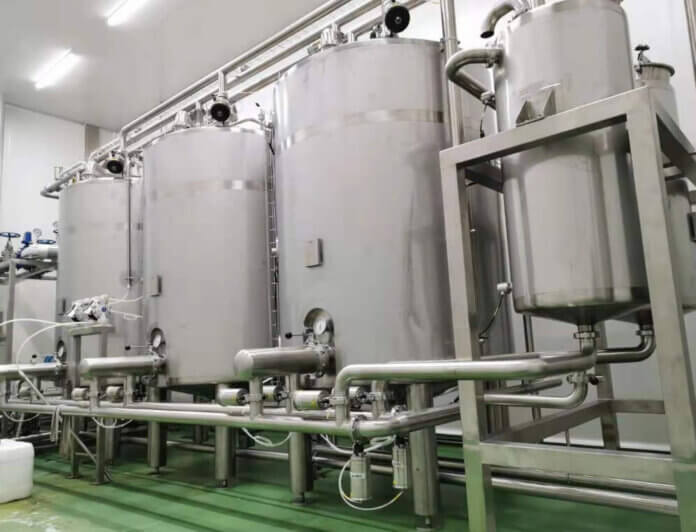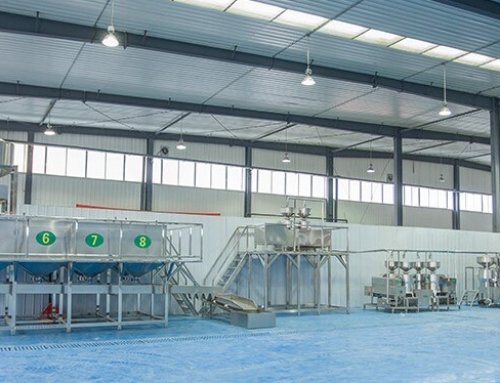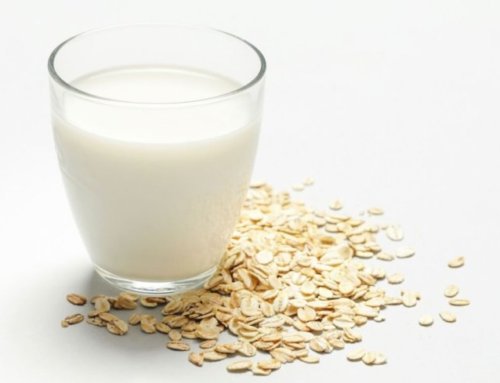Project Description
Almond Milk Processing Line
Description Of Almond Milk Processing Line
- Almonds are rich in nutrients, protein, vitamins and amino acids. Almonds contain 45%-50% fat, 25% protein, 8.5% total sugar, 8.8% crude fiber, and 3% amygdalin. In addition, it also contains Ca, P, Fe, and K. The content of Ca, K, and P is 3-6 times that of cow’s milk. It is an extremely high-quality natural plant-based protein milk.
- Almond milk is emulsified with almond pulp, pure water, sugar, emulsifiers and flavors as raw materials. It is a turbid milk protein drink. The content of almond fat is high, so it is necessary to add water to dilute the fat during the grinding process, the ratio of almond to water is 1:10. In the process of almond dilution process, the almond content is 5%, the amount of sugar is 8%-10%, the amount of emulsifier is 0.3%, the flavor is 0.02%, and the pH value of the prepared almond milk is 7.1.
- Almond milk production line includes blanching and peeling system, disinfection and washing system, grinding and filtration system, blending system, vacuum deodorization, homogenization sterilization system, filling and packaging system, CIP cleaning system, RO pure water generating system, etc.
- The processed almond milk can be filled into PE or glass bottles, aseptic cartons, gable top cartons or tinplate cans; the production line capacity is 500LPH-10000LPH available; The raw material for almond milk production can be dry almonds or almond paste.
- The equipment of the entire production line is made of SUS304, which complies with food production safety regulations.
- The almond milk production process involves soaking almonds in water, grinding the almonds into paste, filtering it through a fine mesh to remove solids, adding additives such as sweeteners and emulsifiers and blending the mixture, homogenizing and degassing the almond milk, pasteurizing/sterilizing, and packaging the resulting almond milk into containers.
- The amygdalin in almonds hydrolyzes cyanide under acid or enzymatic heating conditions, which is a highly toxic substance, but hydrocyanic acid is volatile and can be removed with a little heating. In view of this feature, we use high-temperature water-soaking pre-cooked almonds and hot blending methods to process almond milk.
- The almond milk production line/machine can also be used for producing walnut milk and peanut milk, as they have similar features and physical and chemical properties.
- We have summarized some Frequently Asked Questions about the almond milk processing project.
The End Products and Package Of Almond Milk Processing Line
Almond milk should be milky white or slightly off-white, with a unique aroma and taste of almonds, showing a uniform and delicate emulsion, with a soluble solid content of 6-9 Brix or 9-12 Brix, protein content between 0.5%-1.2%, and fat content is between 1.1%-1.5%.
Almond milk in PE or glass bottles or tin cans: This type of milk is pre-pasteurized, then filling into containers, after filling, the container needs to do the secondary sterilizing by retort sterilizer. The shelf life of this type of milk can reach 9-12months depends on whether you add the preservatives and sterilizing temperature.
Almond milk in aseptic brick cartons: This type of almond milk will be UHT sterilized and filled into aseptic cartons, and the almond milk does not need to add antioxidants, the shelf life can reach 8-12 months according to the carton types and ingredients.
Almond milk in gable top carton: This type of milk will be HTST pasteurized, then cool down to 4℃, and then cold filling into cartons. The carton almond milk storage, transportation and sales need to in a cold environment and shelf life is 7-10 days.
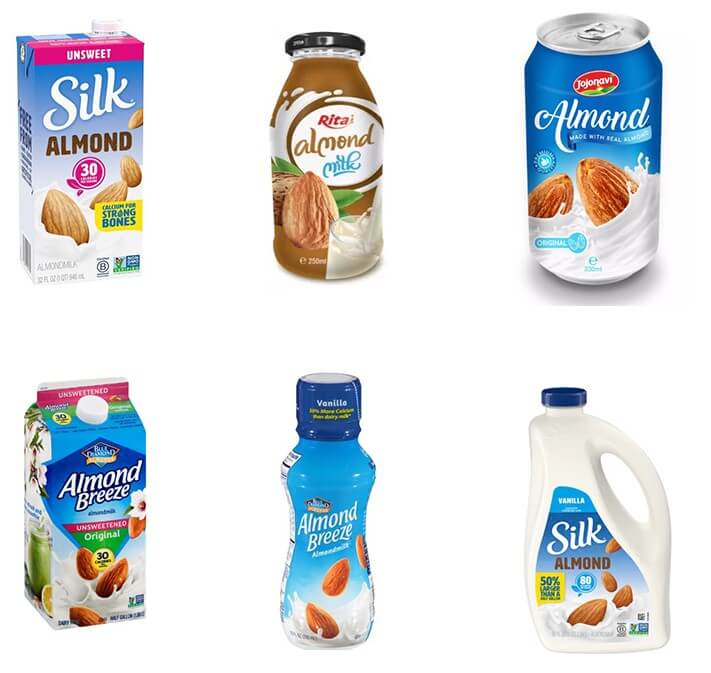
Technological Flowchart Of Almond Milk Processing Line
Dry almonds as raw material: Use dried and dehusked almonds as raw materials, blanch them in 90-95℃water for 3-5 minutes to soften the almond skins, and then lift the softened blanching almonds to a roller peeling machine to remove the skin by an elevator, and then the peeled almonds transported to the drum washing machine for cleaning and disinfection, after that they can be transported to colloid mill or ultra-micro mill for refining. The obtained almond paste is filtered through a 200-mesh filter and then transported to a blending tank through a pump to mix with water, sugar and other ingredients. Finally, the evenly mixed almond milk is degassed, homogenized and sterilized, and filled in small packaging containers.
Almond paste as raw material: Dissolving the ingredients such as sugar, flavor agents, and emulsifier in the high-speed dissolving tank, after filtering, then pumping into the blending tank. At the same time, unload and pump the almond paste to the blending tank to mix the almond paste and water emulsion evenly, then transfer to the high-pressure homogenizer and UHT sterilizer to do the heat treatment and homogenizing, at last, the almond milk can be packed into bottles, cans or cartons.

Key Machine Of Almond Milk Processing Line
Almond blanching and peeling machine
The wet type almond blanching and peeling machine is suitable for blanching almonds and removing the brown skin on the almond kernels. The whole machine is made of SUS304 material and the capacity is 50-300kg per hour. The almond peel rate is 98% and the broken rate is less than 1%.
Soak the almonds in the hot water of the feeding hopper for 5-6 minutes, after blanching the almonds will be fed into the rubber wheel, the rotating rubber roller will rub the almonds and peel off the soft almond skin easily. After peeling, the almonds kernel is intact and perfect.
Almond grinding machine and filter
The almond refining adopts a two-stage colloid mill to grind. The material-to-water ratio during refining is controlled at about 1:10, and then filtered through a vibrating screen of about 200 meshes, so that the fineness of particles in the material liquid is about 20μm, and the refining water is RO pure water, color protection liquid can be added during the refining process to protect the color of the product.
When the processing capacity is big( more than 2 tons per hour), the wet-type milling machine is suggested to grind the almonds into the almond pulp. When grinding, pure water will also need to add to the machine to increase the working efficiency and high-quality products.
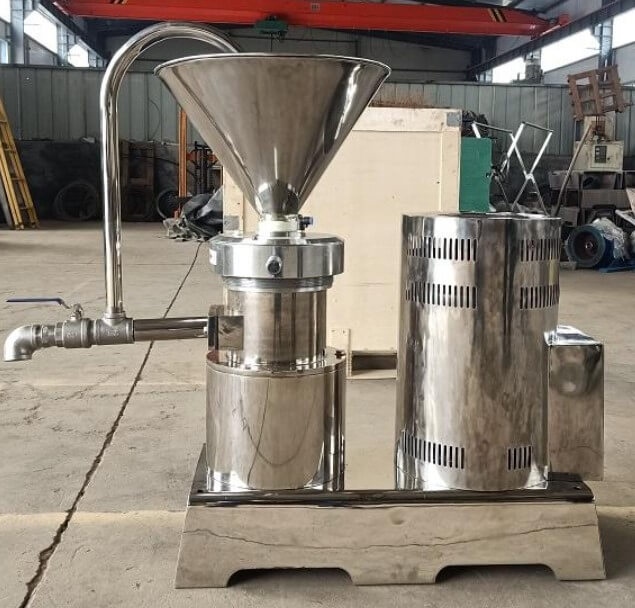
Almond milk preparation and ingredients blending system
The function of the blending tank is mainly to mix almond paste, syrup, emulsifier, and other flavor substances in a constant volume according to a certain formula. The tank is SUS304 material, tripe layers and with stir, it can be heated by steam or electricity, easy to use and maintain.
When blending the ingredients, all ingredients dosing precision is the key process index that determines the end product quality, to ensure that every ingredient feeds into the mixing tanks according to the recipe, the load cells can be equipped with on the tanks and mixproof valve system can also be adopted to the blending system.
To ensure the good viscosity, texture and flavor of almond milk, the type of agitator and blending time and temperature are vital. We can choose the most suitable agitator according to the clients’ emulsifier type based on our abundant experience in handling different materials blending and dissolving.
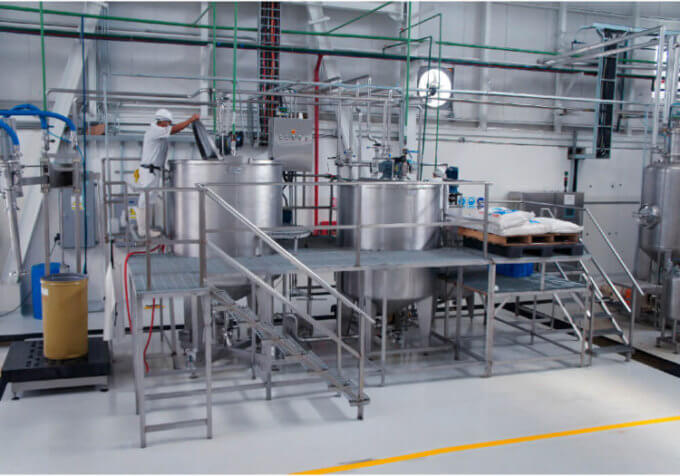
High-pressure homogenizer, vacuum degasser and UHT sterilizer for almond milk processing
The prepared almond milk is homogenized, the temperature is maintained at 60-70℃, and the homogenization is divided into two stages, the homogenization pressure is 20mpa and 35mpa, and the diameter of the almond particles after homogenization is less than 5μm.
The vacuum deaerator can remove the peculiar smell and air in the almond milk, so that the final product has a good flavor and effectively extends the product shelf life.
There are two sterilization processes for almond milk, one of which is HTST pasteurization (75-80°C for 15S), after the pasteurization is completed, the material is cooled to about 4 degrees for filling. The other is UHT sterilization (135-137°C for 3-5S) or DSI sterilization, after sterilization, the material is cooled to 89°C for hot filling or 30°C for aseptic filling.
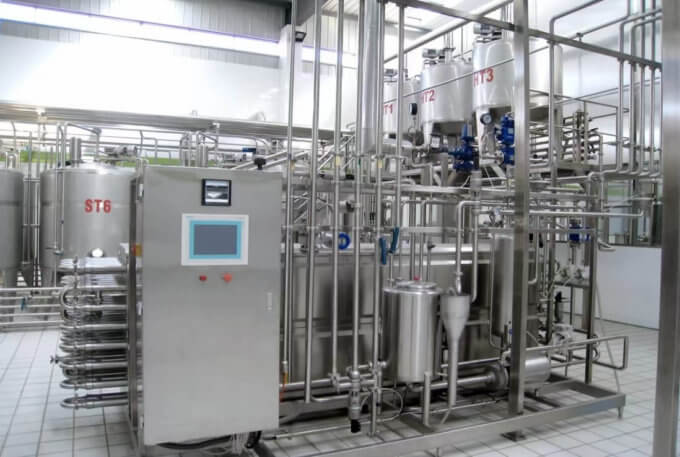
Almond milk filling machine
There are three types of filling machine for almond milk,
The first is 89℃hot filling, after filling into containers, to extent the shelf life of the products, the container needs to do the secondary sterilization by retort sterilizer. But this type of almond milk has a lower quality flavor and nutrient.
The second is 30℃aseptic filling, there is no need further process after almond milk filled into the aseptic cartons. Due to the short heating time of the material, this processing method keeps the nutrients and flavor in the almond milk well. But the aseptic filling line needs to make a big investment in equipment.
The third is 4℃cold filling, after the almond milk is filled into cartons or bottles, there is also no need for secondary sterilizing process. This processing method keeps the natural nutritious and flavor in the material to the maximum extent, but the only weak point is that the product shelf life is short and needs to do cold chain distribution.

Almond milk retort sterilizer
If the almond milk hot filling into bottles or cans, then after filling, the milk in containers needs to do secondary sterilizing by the retort sterilizer. The sterilizing flowchart for almond milk is 85℃—heating to 121℃ holding for 15-20minutes–cooling to 30℃ for packing. The stationary type water bath or spray type retort sterilizer is applied to treat the almond milk.
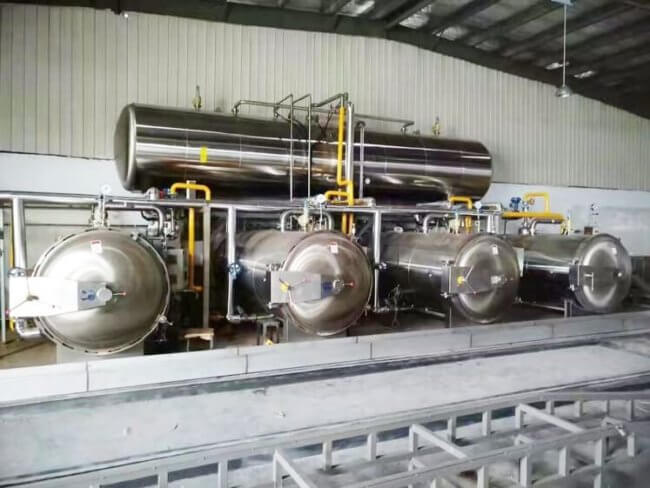
CIP cleaning system for almond milk processing
A Clean-in-Place (CIP) system is essential for maintaining hygiene in almond milk production, ensuring that all equipment, tanks and pipelines are thoroughly cleaned and sanitized without needing to disassemble the system. This process is crucial in the food and beverage industry to prevent contamination, extend equipment life, and comply with stringent food safety regulations. The CIP cleaning procedure for almond milk production is as follows:
- Pre-Rinse(Freshwater cleaning):
- Objective: To remove loose product residues and debris from the equipment.
- Process: Fresh water is circulated through the system to flush out the majority of the almond milk residues. This step reduces the load on subsequent cleaning stages.
- Duration: Typically 5-10 minutes.
- Caustic Wash (Alkaline Cleaning):
- Objective: To break down fats, proteins, and organic matter, which are common in almond milk residues.
- Process: An alkaline solution, typically sodium hydroxide (NaOH) at concentrations of 1-2%, is circulated through the system at elevated temperatures (usually 60-80°C). This step emulsifies and removes the organic residues.
- Duration: 20-30 minutes, depending on the level of contamination and system complexity.
- Intermediate Rinse:
- Objective: To remove residual caustic solution from the system.
- Process: Fresh or recirculated water is used to rinse out the alkaline solution. This prevents any chemical interaction with the acid wash in the next stage.
- Duration: 5-10 minutes.
- Acid Wash:
- Objective: To remove mineral deposits (scaling) and neutralize any remaining alkaline residues.
- Process: An acidic solution, often phosphoric or nitric acid at concentrations of 0.5-1.0%, is circulated at moderate temperatures (50-70°C). This step also helps in removing any scale that might have formed during production.
- Duration: 20-30 minutes.
- Final Rinse:
- Objective: To ensure all cleaning agents are thoroughly removed, leaving the system clean and free from residues.
- Process: A final rinse with fresh water, potentially followed by a conductivity test to ensure no residual chemicals remain.
- Duration: 10-15 minutes.
